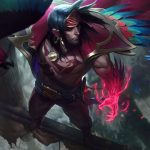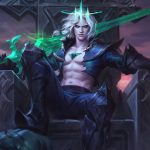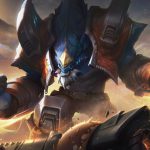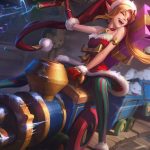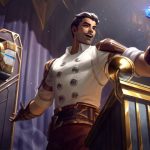.jpg)
Introduction
Brand is a popular League of Legends champion whose abilities make him a powerful mage. His abilities allow him to do major damage to enemies, and he can also set up powerful combos with his ally champions. He is an excellent choice for teamfights and can quickly turn the tide in a team’s favor. His unique abilities also make him a viable pick in most roles.
This article will discuss all of Brand’s abilities, as well as some strategies and tips for using him effectively:
Overview of Brand
Brand is a ranged mage champion in the game League of Legends. His primary role is to provide area-of-effect (AOE) lockdown and heavy damage output. Brand’s damage comes from his abilities which are focused on splash damage and heavy area of effect fireballs that can be used to control or eliminate enemies.
His passive, Blaze, enhances his ability to do splash damage with every third ability hitting all surrounding enemies for bonus magic damage. With his ultimate, Pyroclasm, he can engulf the entire map in flames for a large burst of magic damage and crowd control.
Brand’s kit rewards good positioning as when placed well he can quickly decimate enemy teams before they realize what’s happening. He also has high wave clear potential due to his ability Pillar of Flame, which allows him to easily clear out minions or monsters with a powerful stream of fireballs.
The champion’s efficacy depends largely on the player’s skill level and coordination with team members as working together allows Brand players to have the greatest impact during team fights.
What Role Does Brand Play
Brand is a unique champion in Riot’s Multiplayer Online Battle Arena (MOBA) game, League of Legends. Brand’s abilities focus on dealing fire damage on his opponents throughout the teamfight, allowing him to take down his enemies in quick succession. According to Blizzard Entertainment, “Brand excels at punishing enemy teams for clumping together by raining fiery death upon them from afar.” The introduction of Brand means that playing him effectively requires a strong understanding of not only his kit but also the possible counterplay choices for enemy teams.
Brand is classified as an Apollyon or Mage Champion and is primarily used as a mid-lane or ‘roaming’ mage. He has exceptional damage output and area-of-effect (AOE) capabilities with his ultimate ability Pyroclasm proving especially damaging during team fights and sieges. His skillset makes him a great option when playing supportive roles through ganks and lane dominance while also offering significant pick potential due to his long range zoning capabilities and late game carry potential.
Overall, Brand proves to be an extremely versatile champion in League of Legends who excels when paired with other champions and can perform well as both an offensive powerhouse or in more supportive roles. As a result, playing Brand is often more fruitful when teams coordinate their efforts in order to maximize the utility from all their picks alongside that of Brand’s’:
Abilities
Brand, The Burning Vengeance is a powerful mage in League of Legends. He has a wide range of abilities that allow him to deal massive amounts of damage to both his enemies and his allies.
The following will provide a breakdown of all of Brand’s abilities, including their damage output, cooldowns, and range:
Passive Ability
Each League of Legends champion is different and unique in terms of abilities and playstyle. Every champion has a passive ability, meaning an ability with no cost, cooldown or activation requirement. Passive abilities can be triggered automatically upon meeting specific conditions such as attacking an enemy or using another spell.
For the League of Legends champion Diana, her passive ability is “Moonsilver Blade”. This enables her to receive a bonus to attack speed every third basic attack she makes on an enemy champion. Additionally, the third attack will slash enemies around her dealing damage in an area of effect around her target.
Passive abilities are often overlooked but they can have a significant impact on how each champion performs in game. Taking advantage of your passive can make you more efficient and effective in battle!
Q Ability
Q-Ability, also known as Quest Ability, is a system of levels and abilities introduced in Final Fantasy X. The system allows the player to level up various attributes and abilities by performing various tasks throughout the game world. Q-Ability is also tied to the characters’ Sphere Grids, as each ability requires certain Sphere Levels and certain items to be used.
The system is divided into four categories of abilities:
- Power Up abilities function similarly to a traditional RPG stat boost but apply it directly to a player’s stats such as HP, MP or Strength by equipping an item like armor or gauntlets. This is helpful when needing more defense from enemies or when need more MP for healing spells.
- Support Effects are passive status bonuses that last until equipped items are changed out or until a scenario ends. Players can choose from up to four varying amounts for each Support Effect; higher numbers correspond with stronger effects. Examples include increased evasion rate against physical attacks or improved mana regeneration rate over time (MP regen).
- Elementalist Abilities boost elemental powers such as Fire Mastery which allows character attacks to recharge their Mana faster if those attacks land successfully on an enemy entity weak against Fire Magic (like undead monsters).
- Summon Abilities allow characters to summon powerful monsters such as Ifrit who will temporarily fight alongside them in battle with special damaging and support spells tailored toward specific enemies encountered that day within Final Fantasy X’s virtual world.
W Ability
The W ability of the champion is called “Shroud of Stillness“. Upon using the ability, a zone of menacing hush falls over nearby enemies. For 2 seconds, all non-champion units entering and leaving the area will be slowed by 75%. Champions inside are instead rooted in place, unable to move. Enemy champions that took damage from any source will be slowed by 95% instead. The slow duration decays over time and soon these champions may resume their activities.
The affected region affects an area with a radius of 425 for both enemy and ally champions and lasts for 5 seconds at its maximum duration.
- Shroud of Stillness
- Cooldown: 18/ 16 / 14 / 12 / 10
- Mana cost: 50
E Ability
The E ability of Brand, Blaze, is a powerful area-of-effect spell that can damage and spread his total damage to enemies in an area. It is almost the same as Brand’s Q ability, Sear, except it has a larger diameter and a much wider range.
When this ability is cast, a line of flame spreads outward from the location of Brand’s chosen target, dealing increasing amounts of magic damage to any enemies caught in its path. After reaching its maximum distance, the flames linger for a brief time before gradually dissipating. Seared targets are dealt additional magic damage every 0.5 seconds for 4 seconds as long as they stay within Blaze’s radius.
As with all other mage quesits, it should be used with caution as it can easily create an overload if used recklessly in team fights or large group skirmishes.
R Ability
R – Aoe Damage/Ultimate Ability: This champion’s ultimate ability is a powerful Area of Effect (AoE) dealing damage to all enemy units in the target area. This ability can be used to clear waves, quickly break enemies’ defensive formations, punish grouped up enemies, and is the ultimate source of zone control. When used correctly this champion’s ultimate can turn fights and win the game instantly!
Tips and Tricks
Playing Brand in League of Legends can be very rewarding and fun if you know how to use his skills correctly. His kit is versatile and can be used in various ways that can be beneficial to you and your team.
This section will cover tips and tricks on how to get the most out of Brand’s kit. We’ll go over his abilities, synergies, and more so you can be a pro at playing him:
Early Game
Early in the game, players should focus on gathering resources and building up their structures. Collecting wood and ore as quickly as possible will help players expand their base and develop better defenses against enemy attacks. Additionally, collecting food sources to support troops takes priority early on to support large scale operations. Investing in upgrades immediately can also give technology needed for efficient resource management and increased output from resources such as gold or mana.
Developing a strong economic structure helps to ensure successful expansion later on and offers steady income while launching early attacks. Establishing a well-rounded army is also important; although there are no definitive rules when it comes to troop composition, having an equal mix of ranged and melee units is always recommended. Scouting the area regularly is key in keeping enemies at bay and using natural obstacles like streams or mountains as defensive barriers helps defend against larger armies. In multi-player games, team work between players usually gives an advantage over opponents when it comes to besieging enemy castles.
Mid Game
Once laning phase has ended, players need to switch their focus to the teams’ collective goal of taking down towers and other objectives such as Baron Nashor and Dragon. During this part of the game, the team should make sure they have vision control, dragon control and rotate between lanes quickly. When taking objectives like towers or Dragon it is important for one champion to be assigned as initiator with your remaining 4 champions acting as follow-up crowd control.
Crowd Control (CC): Crowd Control refers to any ability that can disable an enemy champion in order to give your team an advantage. CC can come in many forms such as knock-ups, silences, stuns, slowdowns and more. The Champion you are playing might have a form of CC built into their kit so make sure to use it every chance you get when engaging a fight!
Positioning: Knowing how and where to position yourself during fights is one of the most important skills you can learn when playing any Champion in League! During fights you want to try and stay close enough that you can fight but far enough away that you don’t get caught out by enemy CC or burst damage. Your positioning also depends heavily on what role your Champion is assigned too – for example if you are playing an assassin then getting into a vulnerable position behind enemy lines could be beneficial whereas if your Champion is more supportive then staying towards the back line might be better.
Team Fighting: Once all five members of each team have grouped up together for a fight – then it’s time for Team Fighting! Team Fighting refers to anyone engaging in full five-man team fights during mid game, where all five Champions from both teams gather together with the intention of picking off weaker champions or making certain lanes push faster than others via sieging towers together with minion waves backing them up. Always assess each situation before jumping straight into a team fight as having one champion missing could be detrimental in some cases where winning 5v4 instead would actually be better for your team’s chances at winning that game!
Late Game
At this stage in the game, many players will have developed strong strategies that involve a variety of different units and tactics. Often, the best thing to do is simply to continue refining your strategy by trying out different unit combinations, army sizes, and technology upgrades. Additionally, it is helpful to keep an eye on the battlefield and be ready to adjust your strategy quickly when necessary.
It is also important to pay attention to timing and resources when planning an attack or defense. For instance, understanding when certain resources refresh or become available can save you valuable time, while researching certain technologies can give you an edge in combat. Having a combination of long-term planning and quick reactions is necessary for success late in the game.
Finally, it can often pay off to take risks late in the game – experimenting with different approaches can lead you down a path with increased rewards but also increased risks as well. It can also be beneficial to look ahead at possible outcomes so that you are ready for all possibilities – good or bad – and adapt accordingly.
Matchups
Matchups are one of the most important factors when it comes to playing any champion in League of Legends. Understanding how a champion will interact with their opponents can help you make the best decisions in-game.
In this article, we’ll look at Brand’s matchups and what to look for when playing against opponents.
Easy Matchups
Easy matchups in League of Legends (LoL) are games where one champion has a clear advantage over the other. This might be because of their ability to control the enemy champion more easily, or have some form of crowd control that makes it easier for them to win the match.
Champions with strong ranged abilities, such as fighters and supports, are especially useful in easy matchups. Champions like Vayne or Zyra can stay out of melee range and deal damage from a safe distance. Support champions like Sona and Soraka can set up their teammates for success by granting them shields or healing them permanently.
In addition, champions with area-of-effect crowd control effects, such as blitzcrank with his notorious grab, also tend to perform better in easy matchups due to their potential to enable their teammates further during team fight scenarios. Other powerful amongst these include Lee Sin’s Sonic wave and Malphite’s earthquake.
Having a well rounded laning phase will give you the edge over your opponents while playing an easy matchup since you will be able to make plays easier and have enough resources at your disposalcome late game team fights. Choosing when to engage is key when playing an easy matchup since you often have a high chance of winning if done correctly.
Medium Matchups
Medium matchups are the champions in League of Legends that have skills which match up with the champion you are playing at a moderate level. While they may be able to push your champion a little bit, they won’t necessarily dominate you or force you out of lane. Your champion still has a fighting chance here, but you need to play smart and not get overly aggressive.
The most important thing to remember when facing a medium matchup is that it is important to play safe and make sure your health bar stays full throughout the match. You don’t want to use your summoner spells too early, as these could be more useful later on in the game if things get tough. Pay close attention to how the champion is playing, and if possible, try whatever counter strategies may work against them.
Common medium matchups include Yasuo, Jinx, Jax, Katarina, Ashe and Darius. However depending on how players build up their champions these matchups can range from easy wins to unwinnable ones. It all depends on proper itemization and understanding of their kit, as well as having any areas of vulnerability that can be exploited in order for the player to outplay their opponent. Overall this tier gives players (especially newbies) an opportunity to learn different counterstyles without feeling too overwhelmed or outplayed when facing them, as opposed to say “Hard” opponents who have more chances of outplaying in certain situations, thus requiring better knowledge and quick reflexes from each player involved.
Hard Matchups
Competitive gaming is full of complex metas, strategies and team compositions. Hard matchups refer to when one team composition excels against another, making it difficult for the other side to find any kind of advantage in the game. Since every situation is unique and players have different skill levels, hard matchups can often make even experienced gamers struggly to overcome.
Common characteristics of hard matchups include:
- Very limited counters
- Contentious early-game plays that prevent the other team from catching up in gold income or base experience
- An undeniably overwhelming level of pressure from the opposing team.
Whilst many teams are able to make adjustments throughout a game’s progression, hard matchups can often lead to a blitzkrieg victory for one players before both sides have fully established control on their turrets and objectives.
For those accustomed to fairly predictable matchups, playing against a hard matchup can be intimidating at first. However, understanding how your opponent plans or attempts to execute their strategy will give you a better indication of potential counterpicks and how best to tackle a situatuion when considering long term success as well as short-term gains.
Builds
When you start playing League of Legends (LoL), you need to understand how to strategically build each champion. Depending on the champion you chose, you will want to pick the items and runes that will give you the best chance at success and victory. Developing the right builds are key to successfully playing LoL, so let’s dive into what you need to know.
Core Builds
When deciding on the best build for your chosen champion, there are a few key factors that you should consider:
- What play style do you prefer? Do you like to play aggressively and dive right in, or would you rather take a more calculated approached and pick off enemies from the side lines? The core build outlines should be adjusted depending on your own individual preferences.
- What kind of composition does your team have? Depending on whether your team is predominantly offensive or defensive, different builds may be more effective than others. The core items for each build support the team’s wider strategy; for example if your team consists of big physical damage dealers then basic attack damage items such as Infinity Edge can be very helpful.
- What type of champion are you playing against? It may be wise to stack up armor or magic resist depending on their champions or weapon sets. An amphibious character such as Wukong needs protection against both physical and magical damage in order to function optimally, so focusing on defense-oriented armors such as Thornmail or Locket of Iron Solari can give him security against both his opponents and his nemesis.
Overall there are many possibilities when selecting builds for your champion but by prioritising these three key elements you will greatly increase the chances of success!
Situational Builds
When you play League of Legends, it’s important to have a solid build plan to ensure the success of your team. Different champions require different builds depending on their playstyle and your opponents’ lineup. Although a core build is generally recommended, some champion builds will require adjustments based on the specific situation and performance goals. Below are some tips for success when considering situational builds in LoL.
- Objective-based Considerations: Before building a champion, it is important to consider your playstyle and goals within the current match. Are you playing to win lane or hunt down objectives around the map? Do you prefer building burst damage items or essential tank items? Thinking ahead about how your build can complement the strategy of your team and increase player success is essential for any LoL match.
- Enemy Team Composition: In addition to setting objectives for yourself, it’s also important to analyze enemy team composition when creating your situational builds. Knowing whether or not most of their champions are physical or magical damage dealers can help determine what types of items players should use in order to be successful against them throughout the game.
- Counter-Items: Depending on which opponent you are laning against in a game, some players may choose specific counter-items that can give them an edge over their enemy champion – even if they don’t buy those particular items often! For example, if facing an opponent with a lot of health regeneration capabilities, purchasing an item with spell vamp can make it harder for them to stay alive in battle before having to return back home.
Situational builds can be difficult tasks within any LoL match but with thoughtful consideration from each player – especially during occasional out-of-the-ordinary games – successful strategies can turn into victorious matches!
Summary
Brand is a powerful and versatile champion in League of Legends. His abilities can be used to wreak havoc on the enemy team, both through offensive and defensive measures. He is especially effective when played in the mid lane, but can also be used in the top and bottom lanes. His kit includes a stun, several area of effect damage spells, and a long-range ultimate.
In this section, we will go into detail about his abilities, weaknesses, and strategies for success:
Strengths and Weaknesses
Syndra is a powerful mage of considerable skill. Her control of Dark Spheres gives her the ability to match and outmatch many opponents. Her magical capabilities are enhanced further by her Unraveled Earth ultimate, which traps enemies within an intricate and deadly web that can easily be turned against them.
Strengths:
- Can trap opponents in any arena with her ultimate ability, Unraveled Earth
- Her Dark Spheres give her great area of effect damage and crowd control abilities
- Capable of dishing out huge amounts of single target damage
- Extremely adept at managing lane pressure
- High value pick for team fight engagements
Weaknesses:
- Vulnerable to crowd control abilities since she has an all magical kit
- Can lack mobility when she doesn’t have Unraveled Earth available
- Susceptible to pushing as her moveset is very static
- She struggles soloing against melee champions who can close the gap easily
Final Thoughts
Overall, Brand is a powerful late-game champ whose long-range spells and hard-hitting combos can easily turn the tides of any fight. He is a great choice for anyone looking to dominate their opponents with long range damage. Despite his general low movement speed, he can use his Blaze passive to make quick escapes in times of danger. When it comes to team fights his crowd control and AoE damage can really make a difference.
Brand is not truly viable as a solo queue carry, but he is still an excellent pick up for the mid lane. His strong kit allows him to easily assert dominance over the mid lane, pushing out whatever champions aren’t too tanky and have weak area damage capabilities. Brand has really found dominant use in team compositions that revolve around cc locks down or heavy AoE area control (especially when combined with Fiddlestick’s ultimate). And if you are fortunate enough to have some defensive tanks on your team Brand can quickly and effectively burst down any tanky targets your team needs removed from the field of battle.
Whether you are looking for a high impact mid laner or an advantageous engage/disengage tool in team fights, Brand can provide all these roles with consistency when played correctly. He will become especially deadly when paired with mages who have both massive crowd control effects and large area damages – providing your composition (either top/bot or mid) with immense frontline durability while allowing Brand to rain fire upon enemy’s as they try survive into better positioning near towers or friendly zoning effects like Bard’s Ultimate Cosmic Leap or Alistar+Leona’s Trinion Dive).
Frequently Asked Questions
Q1: What is Brand?
A1: Brand is a champion in the game League of Legends. He is a fire-wielding elemental mage with an array of explosive spells at his disposal.
Q2: What are Brand’s abilities?
A2: Brand’s abilities include Pillar of Flame, Sear, Conflagration, Pyroclasm, and Blaze.
Q3: What role does Brand play in League of Legends?
A3: Brand is usually played as a mid-laner in League of Legends and is often used as a mage to deal heavy damage to enemies.
